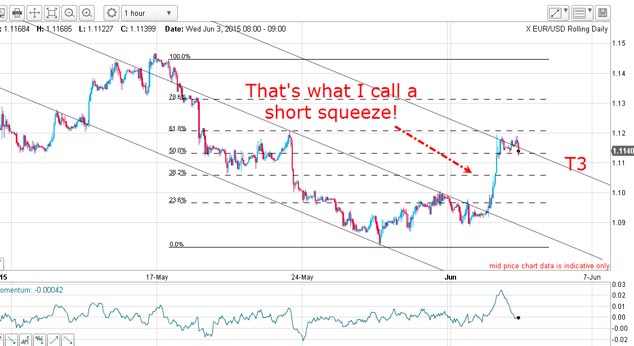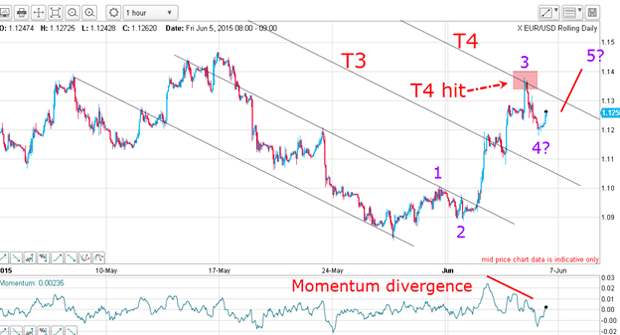A perfect trading opportunity came out of nowhere
Out of the blue, a low-risk trading opportunity arose in the euro market. John C Burford reveals how he played it.
On Wednesday, I decided to trade the EUR/USD, having believed on Monday that there were no low-risk opportunities. How wrong I was on Monday!
Here was the position on Wednesday morning:

The perfect trade entry was given when the market broke up through my centre tramline. But just before that, I found another low-risk entry in the 1.09 region, as I explained.
MoneyWeek
Subscribe to MoneyWeek today and get your first six magazine issues absolutely FREE

Sign up to Money Morning
Don't miss the latest investment and personal finances news, market analysis, plus money-saving tips with our free twice-daily newsletter
Don't miss the latest investment and personal finances news, market analysis, plus money-saving tips with our free twice-daily newsletter
In textbook fashion, the market promptly zoomed up to meet my third tramline, T3. Remember, this tramline is resistance and represents a target where short-term traders could take at least partial profits according to my split-bet strategy.
That little exercise produced a one-day profit of around 250 pips.
But was there more in the tank?
What was the backstory (and did it matter)?
But has the euro collapsed as traders fear that Greece's position within the eurozone is in jeopardy?
Not at all. And that simple fact should make those who take headlines at face value think twice.
In fact, some of the best market moves occur when the news appears very bearish and the market rallies (and vice versa) in a seemingly perverse fashion. I love trading these situations!
The fundamental reason for these counter-intuitive moves is that the market has lined up on one side (the bearish euro side) and that makes the path of least resistance up. That's herding in action and canny traders can take advantage by trading against the herd.
Ashort squeeze validated my tramline time to pull the trigger!
Lo and behold, with an additional squeezing of the shorts, T4 was hit precisely on the nose yesterday. Isn't that pretty?

When the market was trading at the 1.09 level on Tuesday, I could draw in my tramline pair using only a few simple rules.
Then, when the upper tramline was broken, I immediately drew in T3 and set that as my first target. When that target was hit later on Tuesday, I could take partial profits of 250 pips, retaining the other part open (and moving protective stop to break-even, just in case).
When T4 was hit, I took the the final profit of around 400 pips, making a total win of 650 pips. Even on a small bet of £4 per pip, that little two-day campaign netted a cool £2,600 win.
If you did that, you would be out of the market and unconcerned what it did next and looking for the next low-risk opportunity.
In fact, if you find just a few of these set-ups a month, you would be in the professional trader class.
My trade was profitable but it wasn't the only way to play the euro
Let's say you had taken partial profit at T3, kept the remainder and not exited at T4. You would be looking at a valid Elliott-wave count, as I have shown above. My Elliott waves suggest that a new high for the move lies ahead.
The big short squeeze is your wave 3 it is long and strong, after all and the dip yesterday off T4 resistance was wave 4. Now you are looking for a new high above T4 in wave 5. Naturally, you would be looking at taking final profits as close to the wave 5 high as possible.
There is a very large momentum divergence building, which is a warning that the downturn could occur at any time.
One strategy to prevent a massive loss of unrealised profit would be to move your sell stop to the price level where you exited the first time. That would lock in 250 pips profit and a total of 500 pips still a very acceptable result.
Enough on the euro for now!
I'm sure you have noted that I have not covered the Dow for some time. That is because there have been few trading opportunities, but I sense that this will be changing very soon. I expect to be able to cover the Dow next week, so do tune in.
Get the latest financial news, insights and expert analysis from our award-winning MoneyWeek team, to help you understand what really matters when it comes to your finances.
John is is a British-born lapsed PhD physicist, who previously worked for Nasa on the Mars exploration team. He is a former commodity trading advisor with the US Commodities Futures Trading Commission, and worked in a boutique futures house in California in the 1980s.
He was a partner in one of the first futures newsletter advisory services, based in Washington DC, specialising in pork bellies and currencies. John is primarily a chart-reading trader, having cut his trading teeth in the days before PCs.
As well as his work in the financial world, he has launched, run and sold several 'real' businesses producing 'real' products.
-
 What are my retirement income options?
What are my retirement income options?We’re all told to save into a pension, but there’s widespread confusion about how to take an income from our savings and investments at retirement, a new study has found. We look at your retirement income options.
-
 UK interest rates: will the Bank of England lower rates?
UK interest rates: will the Bank of England lower rates?The Bank of England’s Monetary Policy Committee’s (MPC) final interest rates meeting of the year takes place tomorrow (18 December) and most experts expect a cut